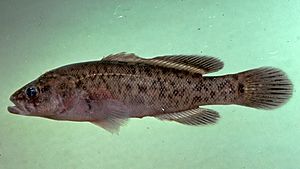Nightfish facts for kids
Quick facts for kids Nightfish |
|
|---|---|
 |
|
| Scientific classification | |
| Synonyms | |
|
The nightfish (Bostockia porosa) is a special type of fish that lives in fresh water. It is a temperate perch from the family Percichthyidae. This fish is found only in southwestern Australia.
What Does the Nightfish Look Like?
The nightfish has a body shape that is a bit like an oval and is flattened from side to side. It has a big mouth that slants upwards, and its lower jaw sticks out a little. Inside its mouth, on both jaws and the roof, it has many tiny, brush-like teeth.
This fish has a special line along its side called a lateral line. This line helps it feel vibrations in the water. The nightfish's lateral line is not complete and has 43 to 47 scales with tubes. You can also see large pores, which are like tiny holes, around its eyes and on the top of its head and jaws.
Its gill cover, which protects its gills, has two sharp points. The fin on its back, called the dorsal fin, has 7 or 8 sharp spines and 16 to 17 soft rays. The third and fourth spines are the longest. There is a deep dip between the spiny and soft parts of this fin.
The fin on its underside, near its tail, is called the anal fin. It has 3 spines and 11 to 12 soft rays. Both the anal fin and the tail fin, called the caudal fin, are rounded.
Nightfish are usually dark olive-purple, black, or dark brown. But if they live in lighter places, they can be light brown with dark brown spots. The longest nightfish ever recorded was about 15 centimeters (6 inches) long. Most nightfish are around 9 centimeters (3.5 inches) long.
Where Do Nightfish Live?
The nightfish lives only in the wetlands along the coast of Southwest Australia. It is quite common in this area. You can find them between the Hill River, near Jurien Bay, and the Kalgan River near Albany.
Nightfish Habitat and Life
Nightfish live in coastal streams, lakes, and ponds. They can be found in clear water or in water that looks dark because of natural plant chemicals called tannins. They like to hide near rocks, water plants (called macrophytes), or sunken wood.
During the day, adult nightfish stay hidden under stones or among plants. They come out at night to find food. Younger nightfish, however, are more active during the day.
Male nightfish can start having babies when they are about one year old. Females start when they are two years old. When the winter rains cause water levels to rise in August and September, the nightfish swim upstream to smaller rivers and streams to breed. Each female can lay between 230 and 1,138 eggs.
The nightfish is a carnivore, which means it eats other animals. They mostly eat small creatures that live on the bottom of the water, like ostracods (tiny crustaceans) and fly larvae. Nightfish can live for up to 6 years.

